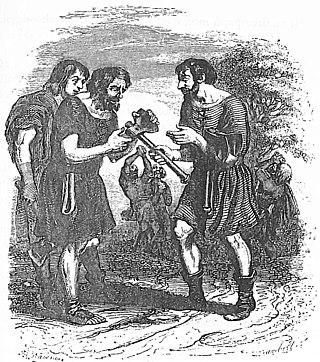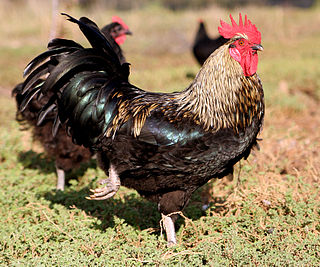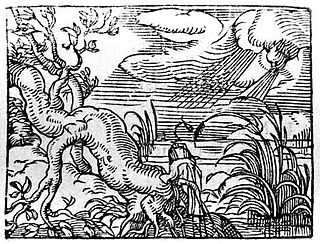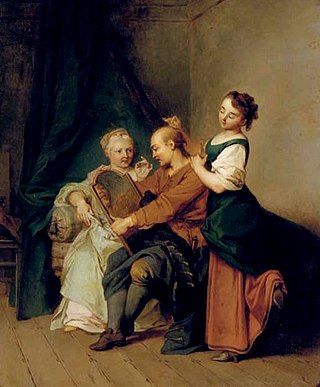
Aesop's Fables, or the Aesopica, is a collection of fables credited to Aesop, a slave and storyteller who lived in ancient Greece between 620 and 564 BCE. Of varied and unclear origins, the stories associated with his name have descended to modern times through a number of sources and continue to be reinterpreted in different verbal registers and in popular as well as artistic media.

The Frog and the Ox appears among Aesop's Fables and is numbered 376 in the Perry Index. The story concerns a frog that tries to inflate itself to the size of an ox, but bursts in the attempt. It has usually been applied to socio-economic relations.

The Ant and the Grasshopper, alternatively titled The Grasshopper and the Ant, is one of Aesop's Fables, numbered 373 in the Perry Index. The fable describes how a hungry grasshopper begs for food from an ant when winter comes and is refused. The situation sums up moral lessons about the virtues of hard work and planning for the future.

The Honest Woodcutter, also known as Mercury and the Woodman and The Golden Axe, is one of Aesop's Fables, numbered 173 in the Perry Index. It serves as a cautionary tale on the need for cultivating honesty, even at the price of self-interest. It is also classified as Aarne-Thompson 729: The Axe falls into the Stream.

The Cock and the Jewel is a fable attributed to Aesop and is numbered 503 in the Perry Index. As a trope in literature, the fable is reminiscent of stories used in Zen such as the kōan. It presents, in effect, a riddle on relative values and is capable of different interpretations, depending on the point of view from which it is regarded.

The Bear and the Travelers is a fable attributed to Aesop and is number 65 in the Perry Index. It was expanded and given a new meaning in mediaeval times.

The Milkmaid and Her Pail is a folktale of Aarne-Thompson-Uther type 1430 about interrupted daydreams of wealth and fame. Ancient tales of this type exist in the East but Western variants are not found before the Middle Ages. It was only in the 18th century that the story about the daydreaming milkmaid began to be attributed to Aesop, although it was included in none of the main collections and does not appear in the Perry Index. In more recent times, the fable has been variously treated by artists and set by musicians.

The Wolf and the Lamb is a well-known fable of Aesop and is numbered 155 in the Perry Index. There are several variant stories of tyrannical injustice in which a victim is falsely accused and killed despite a reasonable defence.
The Bear and the Gardener is a fable originating in the ancient Indian text Panchatantra that warns against making foolish friendships. There are several variant versions, both literary and oral, across the world and its folk elements are classed as Aarne-Thompson-Uther type 1586. The La Fontaine version has been taken as demonstrating various philosophical lessons.

The Fox and the Stork, also known as The Fox and the Crane, is one of Aesop's fables and is first recorded in the collection of Phaedrus. It is numbered 426 in the Perry Index.

The Oak and the Reed is one of Aesop's Fables and is numbered 70 in the Perry Index. It appears in many versions: in some it is with many reeds that the oak converses and in a late rewritten version it disputes with a willow.

The miller, his son and the donkey is a widely dispersed fable, number 721 in the Perry Index and number 1215 in the Aarne–Thompson classification systems of folklore narratives. Though it may have ancient analogues, the earliest extant version is in the work of the 13th-century Arab writer Ibn Said. There are many eastern versions of the tale and in Europe it was included in a number of Mediaeval collections. Since then it has been frequently included in collections of Aesop's fables as well as the influential Fables of Jean de la Fontaine.

Speaking of The Snake and the Crab in Ancient Greece was the equivalent of the modern idiom, 'Pot calling the kettle black'. A fable attributed to Aesop was eventually created about the two creatures and later still yet another fable concerning a crab and its offspring was developed to make the same point.
The title of The Woodcutter and the Trees covers a complex of fables that are of West Asian and Greek origins, the latter ascribed to Aesop. All of them concern the need to be wary of harming oneself through misplaced generosity.

Jean de La Fontaine collected fables from a wide variety of sources, both Western and Eastern, and adapted them into French free verse. They were issued under the general title of Fables in several volumes from 1668 to 1694 and are considered classics of French literature. Humorous, nuanced and ironical, they were originally aimed at adults but then entered the educational system and were required learning for school children.

The Man with Two Mistresses is one of Aesop's Fables that deals directly with human foibles. It is numbered 31 in the Perry Index.

The Heron and the Fish is a situational fable constructed to illustrate the moral that one should not be over-fastidious in making choices since, as the ancient proverb proposes, 'He that will not when he may, when he will he shall have nay'. Of ancient but uncertain origin, it gained popularity after appearing among La Fontaine's Fables.

The classical legend that the swan sings at death was incorporated into one of Aesop's Fables, numbered 399 in the Perry Index. The fable also introduces the proverbial antithesis between the swan and the goose that gave rise to such sayings as ‘Every man thinks his own geese are swans’, in reference to blind partiality, and 'All his swans are turned to geese', referring to a reverse of fortune.
The man and the lion (disputing) is one of Aesop's Fables and is numbered 284 in the Perry Index. An alternative title is The lion and the statue. The story's moral is that the source of evidence should be examined before it is accepted.

The Apeand the Dolphin is one of Aesop's Fables and is numbered 73 in the Perry Index. Due to its appearance among La Fontaine's Fables, it has always been popular in France, but in Britain treatment of the story was rarer until the 19th century.

















